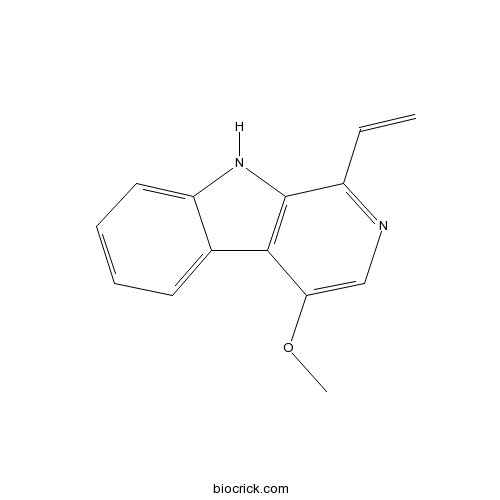DehydrocrenatineCAS# 26585-13-7 |

Quality Control & MSDS
3D structure
Package In Stock
Number of papers citing our products

| Cas No. | 26585-13-7 | SDF | Download SDF |
| PubChem ID | 179485 | Appearance | Yellow powder |
| Formula | C14H12N2O | M.Wt | 224.3 |
| Type of Compound | Alkaloids | Storage | Desiccate at -20°C |
| Solubility | Soluble in Chloroform,Dichloromethane,Ethyl Acetate,DMSO,Acetone,etc. | ||
| Chemical Name | 1-ethenyl-4-methoxy-9H-pyrido[3,4-b]indole | ||
| SMILES | COC1=CN=C(C2=C1C3=CC=CC=C3N2)C=C | ||
| Standard InChIKey | HJVIUZHNRJYUTG-UHFFFAOYSA-N | ||
| Standard InChI | InChI=1S/C14H12N2O/c1-3-10-14-13(12(17-2)8-15-10)9-6-4-5-7-11(9)16-14/h3-8,16H,1H2,2H3 | ||
| General tips | For obtaining a higher solubility , please warm the tube at 37 ℃ and shake it in the ultrasonic bath for a while.Stock solution can be stored below -20℃ for several months. We recommend that you prepare and use the solution on the same day. However, if the test schedule requires, the stock solutions can be prepared in advance, and the stock solution must be sealed and stored below -20℃. In general, the stock solution can be kept for several months. Before use, we recommend that you leave the vial at room temperature for at least an hour before opening it. |
||
| About Packaging | 1. The packaging of the product may be reversed during transportation, cause the high purity compounds to adhere to the neck or cap of the vial.Take the vail out of its packaging and shake gently until the compounds fall to the bottom of the vial. 2. For liquid products, please centrifuge at 500xg to gather the liquid to the bottom of the vial. 3. Try to avoid loss or contamination during the experiment. |
||
| Shipping Condition | Packaging according to customer requirements(5mg, 10mg, 20mg and more). Ship via FedEx, DHL, UPS, EMS or other couriers with RT, or blue ice upon request. | ||
| Targets | Antifection | HSP (e.g. HSP90) | TGF-β/Smad | Mdm2 | Dopamine Receptor | Caspase | NF-kB | IL Receptor |

Dehydrocrenatine Dilution Calculator

Dehydrocrenatine Molarity Calculator
| 1 mg | 5 mg | 10 mg | 20 mg | 25 mg | |
| 1 mM | 4.4583 mL | 22.2916 mL | 44.5831 mL | 89.1663 mL | 111.4579 mL |
| 5 mM | 0.8917 mL | 4.4583 mL | 8.9166 mL | 17.8333 mL | 22.2916 mL |
| 10 mM | 0.4458 mL | 2.2292 mL | 4.4583 mL | 8.9166 mL | 11.1458 mL |
| 50 mM | 0.0892 mL | 0.4458 mL | 0.8917 mL | 1.7833 mL | 2.2292 mL |
| 100 mM | 0.0446 mL | 0.2229 mL | 0.4458 mL | 0.8917 mL | 1.1146 mL |
| * Note: If you are in the process of experiment, it's necessary to make the dilution ratios of the samples. The dilution data above is only for reference. Normally, it's can get a better solubility within lower of Concentrations. | |||||

Calcutta University

University of Minnesota

University of Maryland School of Medicine

University of Illinois at Chicago

The Ohio State University

University of Zurich

Harvard University

Colorado State University

Auburn University

Yale University

Worcester Polytechnic Institute

Washington State University

Stanford University

University of Leipzig

Universidade da Beira Interior

The Institute of Cancer Research

Heidelberg University

University of Amsterdam

University of Auckland

TsingHua University

The University of Michigan

Miami University

DRURY University

Jilin University

Fudan University

Wuhan University

Sun Yat-sen University

Universite de Paris

Deemed University

Auckland University

The University of Tokyo

Korea University
- Harmalacidine
Catalog No.:BCN8033
CAS No.:26579-69-1
- 5-Acetoacetlamino benzimdazolone
Catalog No.:BCC8725
CAS No.:26576-46-5
- Alisol B 23-acetate
Catalog No.:BCN1243
CAS No.:26575-95-1
- Alisol C monoacetate
Catalog No.:BCN2345
CAS No.:26575-93-9
- Z-D-Glu-OMe
Catalog No.:BCC2773
CAS No.:26566-11-0
- 3-Hydroxycatalponol
Catalog No.:BCN5146
CAS No.:265644-24-4
- 2,3-Dihydroxy-12-oleanen-28-oic acid
Catalog No.:BCN5145
CAS No.:26563-68-8
- 8-Phenyloctanoic acid
Catalog No.:BCC8790
CAS No.:26547-51-3
- Apiin
Catalog No.:BCN2311
CAS No.:26544-34-3
- (-)-Hinokinin
Catalog No.:BCN3227
CAS No.:26543-89-5
- Ryuvidine
Catalog No.:BCC7432
CAS No.:265312-55-8
- GW 7647
Catalog No.:BCC7150
CAS No.:265129-71-3
- Crenatine
Catalog No.:BCN5148
CAS No.:26585-14-8
- SCH 202676 hydrobromide
Catalog No.:BCC7049
CAS No.:265980-25-4
- Z-D-Ala-OH
Catalog No.:BCC3059
CAS No.:26607-51-2
- 3-Ethoxyandrosta-3,5-dien-17β-ol
Catalog No.:BCC8631
CAS No.:26614-48-2
- Zotepine
Catalog No.:BCC7838
CAS No.:26615-21-4
- Fmoc-β-Homo-Met-OH
Catalog No.:BCC2630
CAS No.:266359-48-2
- Reparixin
Catalog No.:BCC1885
CAS No.:266359-83-5
- Reparixin L-lysine salt
Catalog No.:BCC1886
CAS No.:266359-93-7
- Conodurine
Catalog No.:BCN7463
CAS No.:2665-57-8
- Salirepin
Catalog No.:BCN5149
CAS No.:26652-12-0
- Dipalmitin
Catalog No.:BCN2214
CAS No.:26657-95-4
- N4-Benzoylcytosine
Catalog No.:BCC9073
CAS No.:26661-13-2
Preparative separation of alkaloids from Picrasma quassioides (D. Don) Benn. by conventional and pH-zone-refining countercurrent chromatography.[Pubmed:24968331]
Molecules. 2014 Jun 25;19(7):8752-61.
Two high-speed countercurrent chromatography (HSCCC) modes were compared by separation of major alkaloids from crude extract of Picrasma quassioides. The conventional HSCCC separation was performed with a two-phase solvent system composed of petroleum ether-ethyl acetate-methanol-water (5:5:4.5:5.5, v/v/v/v) with 200 mg loading. pH-Zone-refining CCC was performed with two-phase solvent system composed of petroleum ether-ethyl acetate-n-butanol-water (3:2:7:9, v/v/v/v) where triethylamine (10 mM) was added to the upper organic stationary phase and hydrochloric acid (5 mM) was added to the lower aqueous phase with 2 g loading. From 2 g of crude extract, 87 mg of 5-methoxycanthin-6-one (a), 38 mg of 1-methoxy-beta-carboline (b), 134 mg of 1-ethyl-4,8-dimethoxy-beta-carboline (c), 74 mg of 1-ethoxycarbonyl-beta-carboline (d), 56 mg of 1-vinyl-4,8-dimethoxy-beta-carboline (e) and 26 mg of 1-vinyl-4-dimethoxy-beta-carboline (f) were obtained with purities of over 97.0%. The results indicated that pH-zone-refining CCC is an excellent separations tool at the multigram level.


